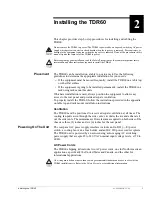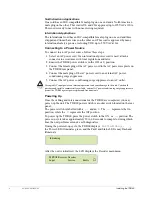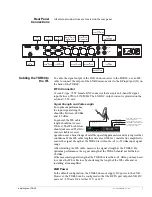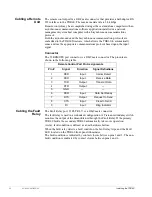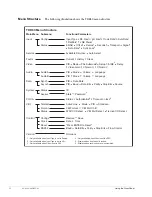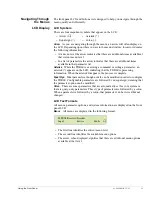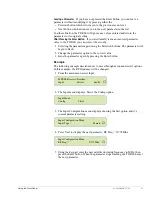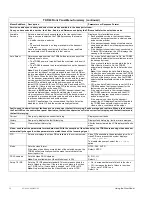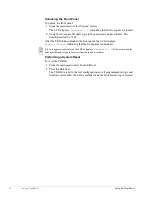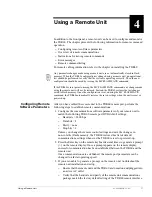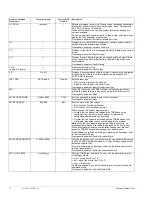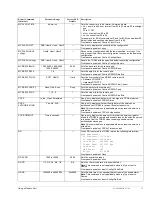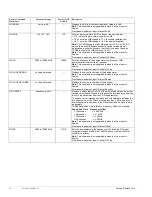
Using the Front Panel
01-0868-401B 12/02
19
DatRate
Sets the data rate.
The data rate is the data rate of the transport stream. To convert
the symbol rate to data rate, use the following equation:
Symbol Rate * 2 * (188/204) * FEC Code Rate = Data Rate
Note
: Only available when Input>Config>Input Type = Demod.
1 - 48 Mbps
Default: 8.448000 Mbps
LNB Power
Sets the LNB power. The TDR60 supplies the LNB power at 13 V
or 18 V to allow an LNB downconverter to set the receive signal
polarization. If you do not need the TDR60 to supply the LNB
power, you should set the LNB Power parameter to Off.
Note
: Only available when Input>Config>Input Type = Demod.
■
13 V: sets the polarization to horizontal
■
18 V: sets the polarization to vertical
■
Off: no power to LNB
Default: off
Input>Status: allows you to display the receive signal E
b
/N
o
level, the carrier Offset, and the current lock status of the demodulator,
decoder, and transport stream.
E
b
/N
0
Query-only; displays the estimated E
b
/N
o
level of the received
signal in dB. The E
b
/N
0
is used with the DVB minimum
performance requirements to indicate the link margin for the
transport stream. The E
b
/N
0
level required for optimum video
performance varies depending upon the FEC code rate of the
transport stream.
The following table lists the minimum E
b
/N
0
levels required for
each FEC code rate to guarantee “flawless” video performance.
Minimum E
b
/N
0
Requirements
Transport Stream
Minimum
FEC Code Rate
E
b
/N
0
Required
1/2
4.5 dB
2/3
5.0 dB
3/4
5.5 dB
5/6
6.0 dB
7/8
6.4 dB
An E
b
/N
0
level at least 3 dB above these limits is reasonable. As
the E
b
/N
0
level drops to the minimum level or below the minimum
level, your video service may be corrupted or interrupted.
Note
: Only available when Input>Config>Input Type = Demod.
estimated E
b
/N
0
level of received signal in dB
Offset
Query-only; displays a measurement in KHz of the difference
between the actual satellite downlink frequency (carrier frequency)
and the frequency determined by subtracting the LO Freq
parameter from the RF Freq parameter.
To achieve carrier (transport stream) lock, the difference between
the two frequencies, referred to as the Offset, must be less than
2 MHz; however, to achieve optimum performance, the Offset
should be as close to zero as possible.
When the TDR60 is trying to lock onto the satellite downlink
frequency, the carrier Offset display varies and does not display a
single frequency for more than a few seconds. Once the TDR60 is
locked onto the satellite downlink frequency, the Offset displays a
measurement that indicates the number of KHz you need to adjust
your RF Freq parameter to achieve optimum performance.
Note
: Only available when Input>Config>Input Type = Demod.
measurement of carrier offset in KHz
Demod
Query-only; displays the current lock status of demodulator
Note
: Only available when Input>Config>Input Type = Demod.
Locked, unlocked
Decoder
Query-only; displays the current lock status of decoder
Note
: Only available when Input>Config>Input Type = Demod.
Locked, unlocked
Transport
Query-only; displays the current lock status of transport stream
Locked, unlocked
Signal
Query-only; displays if the ASI signal is present or not.
Note
: Only available when Input>Config>Input Type = ASI.
Present, Absent
Data Rate
Query-only; displays the transport stream input rate in bps.
Note
: Only available when Input>Config>Input Type = ASI.
2 to 100 Mbps
Sync Lock
Query-only; displays the current lock status.
Note
: Only available when Input>Config>Input Type = ASI.
Locked, unlocked
TDR60 Front Panel Menu Summary (continued)
Menu>SubMenu
Description
Parameters or Response Format

